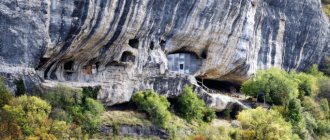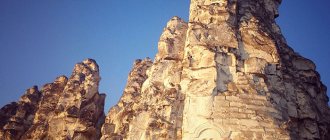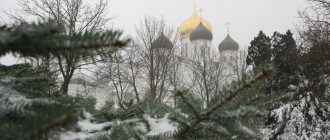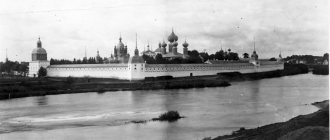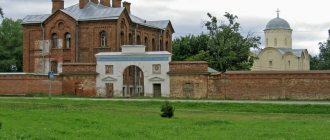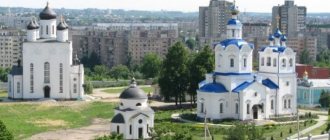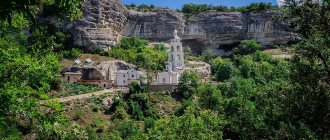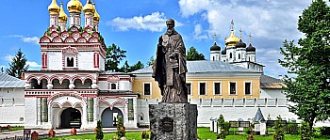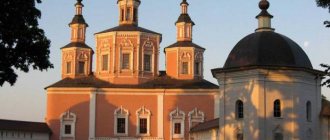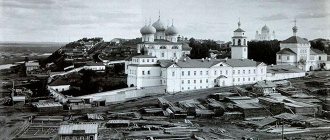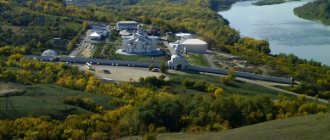Mir
Russia Republic of Crimea Bakhchisaray Bakhchisaray Assumption Cave Monastery Map is loading…
{"format":"leaflet","minzoom":false,"maxzoom":false,"limit":50,"offset":0,"link":"all","sort":[""], "order":[],"headers":"show","mainlabel":"","intro":"","outro":"","searchlabel":"\u2026 \u0441\u043b\u0435\ u0434\u0443\u044e\u0449\u0438\u0435 \u0440\u0435\u0437\u0443\u043b\u044c\u0442\u0430\u0442\u044b","default":"","import-annotation":false,"width ":"auto","height":"350px","centre":{"text":"","title":"""link":"""lat":44.74458299999999866258804104290902614593505859375,"lon": 33.91069399999999944839146337471902370452880859375,"icon":""},"title":"","label":"","icon":"","lines":[],"polygons":[],"circles":[ ],"rectangles":[],"copycoords":false,"static":false,"zoom":8,"defzoom":14,"layers":["OpenStreetMap"],"image layers":[] ,"overlays":[],"resizable":false,"fullscreen":true,"scrollwheelzoom":true,"cluster":false,"clustermaxzoom":9,"clusterzoomonclick":true,"clustermaxradius":80, "clusterspiderfy":true,"geojson":"","clicktarget":"","showtitle":true,"hidenamespace":false,"template":"","userparam":"","activeicon": "","pagelabel":false,"ajaxcoordproperty":"","ajaxquery":"","locations":[{"text":"\u003Cb\u003E\u003Ca href=\"/palomnik/%D0% 91%D0%B0%D1%85%D1%87%D0%B8%D1%81%D0%B0%D1%80%D0%B0%D0%B9%D1%81%D0%BA%D0%B8% D0%B9_%D0%A3%D1%81%D0%BF%D0%B5%D0%BD%D1%81%D0%BA%D0%B8%D0%B9_%D0%BF%D0%B5%D1% 89%D0%B5%D1%80%D0%BD%D1%8B%D0%B9_%D0%BC%D1%83%D0%B6%D1%81%D0%BA%D0%BE%D0%B9_% D0%BC%D0%BE%D0%BD%D0%B0%D1%81%D1%82%D1%8B%D1%80%D1%8C\» title=\»\u0411\u0430\u0445\u0447\ u0438\u0441\u0430\u0440\u0430\u0439\u0441\u043a\u0438\u0439 \u0423\u0441\u043f\u0435\u043d\u0441\u043a\u0438\u0439 \u043f\u0 435\u0449\u0435\u0440\u043d\ u044b\u0439 \u043c\u0443\u0436\u0441\u043a\u043e\u0439 \u043c\u043e\u043d\u0430\u0441\u0442\u044b\u0440\u044c\"\u003E\u0411\ u0430\u0445\u0447\u0438\ u0441\u0430\u0440\u0430\u0439\u0441\u043a\u0438\u0439 \u0423\u0441\u043f\u0435\u043d\u0441\u043a\u0438\u0439 \u043f\u0435\u0 449\u0435\u0440\u043d\u044b\ u0439 \u043c\u0443\u0436\u0441\u043a\u043e\u0439 \u043c\u043e\u043d\u0430\u0441\u0442\u044b\u0440\u044c\u003C/a\u003E\u003C/ b\u003E\u003Chr /\u003E \u003Ca href=\"/palomnik/%D0%A1%D0%B2%D0%BE%D0%B9%D1%81%D1%82%D0%B2%D0%BE:%D0%90%D0%BD %D0%BD%D0%BE%D1%82%D0%B0%D1%86%D0%B8%D1%8F\" title=\"\u0421\u0432\u043e\u0439\u0441\u0442\u0432\u043e :\u0410\u043d\u043d\u043e\u0442\u0430\u0446\u0438\u044f\»\u003E\u0410\u043d\u043d\u043e\u0442\u0430\u0446\u0438\u044f\u003C /a\u003E:\u0412 \u043d\u0430\u0441\u0442\u043e\u044f\u0449\u0435\u0435 \u0432\u0440\u0435\u043c\u044f \u043f\u043e \u0447\u0438\u0441\u043b \u0435\u043d\u043d\u043e\u0441 \u0442\u0438 \u043d\u0430\u0441\u0435\u043b\u044c\u043d\u0438\u043a\u043e\u0432 \u043e\u0431\u0438\u0442\u0435\u043b\u044c \u044f\u0432\u043b\u044f\u0435 \u0442\u0441\u044f \u043a\u0440\u0443\u043f\u043d\u0435\u0439\u0448\u0435\u0439 \u0432 \u041a\u0440\u044b\u043c\u0443. \u041a\u0440\u043e\u043c\u0435 \u043c\u043e\u043d\u0430\u0441\u0442\u044b\u0440\u0441\u043a\u043e\u0433\u043e \u043a\u043e\ u043c\u043f\u043b\u0435\u043a \u0441\u0430, \u043d\u0430 \u043f\u0440\u0438\u043b\u0435\u0433\u0430\u044e\u0449\u0435\u0439 \u0442\u0435\u0440\u0440\u043 8\u0442\u043e\u0440\u0438\ u0438 \u043d\u0430\u0445\u043e\u0434\u0438\u0442\u0441\u044f \u043a\u043b\u0430\u0434\u0431\u0438\u0449\u0435 \u0432\u043e\u 0438\u043d\u043e\u0432,\u043f \u0430\u0432\u0448\u0438\u0445 \u0432\u043e \u0432\u0440\u0435\u043c\u044f \u041a\u0440\u044b\u043c\u0441\u043a\u043e\u0439 \u0432\u043e\u0439\u043d\u044b 1853\u20141856 \u0433\u043e\u0434\u043e\u0432.","title":"\u0411\u0430\u0445\u0447\u0438\u0441\u0430\u0440\u0430\u0439\u0441\u043 a\u0438\u0439\ u0423\u0441\u043f\u0435\u043d\u0441\u043a\u0438\u0439 \u043f\u0435\u0449\u0435\u0440\u043d\u044b\u0439 \u043c\u0443\u0436\u0 441\u043a\u043e\u0439\u043c\ u043e\u043d\u0430\u0441\u0442\u044b\u0440\u044c","link":"","lat":44.74458299999999866258804104290902614593505859375,"lon":33.91069399 999999944839146337471902370452880859375,"icon":""}],"imageLayers":[ ]}
44.748038; 33.906255
Russia, Republic of Crimea, Bakhchisarai, Staroselye quarter
Bakhchisaray, Republic of Crimea
Russia
Telephone:
+7(365-54)4-74-74
Holy Dormition Cave Monastery
- a male monastery of the Simferopol diocese of the Ukrainian Orthodox Church, located in the Mariam-Dere tract (Mary's Gorge) near Bakhchisarai. Currently, the monastery is the largest in Crimea in terms of the number of inhabitants. In addition to the monastery complex, on the adjacent territory there is a cemetery for soldiers who died during the Crimean War of 1853-1856.
History[edit]
Scholars disagree on the circumstances surrounding the founding of the monastery. According to one version, the monastery was founded by Byzantine icon-worshipping monks no later than the 8th century. In the XIII-XIV centuries it ceased its activities for some time, then in the XIV century it was revived. Having escaped defeat during the Turkish invasion in 1475, the Assumption Monastery became the residence of the Gothic metropolitans. However, the financial situation of the monastery was disastrous, which forced them to seek help from the Moscow Grand Dukes and Tsars. This version is confirmed by the discovery of Christian graves near the monastery, dating back to the 6th century.
According to another version, the foundation of the Assumption Monastery dates back to the 15th century. This version was proposed by Alexandre Berthier-Delagarde with reference to now lost manuscripts.
From the 15th to the 18th centuries, the Assumption Monastery was the main stronghold of the religious life of the Orthodox population of Crimea.
Monastery at the beginning of the 20th century
In 1778, the Greek population was deported from Crimea. People from the Greek village of Mariampol, which existed at the foot of the Assumption Monastery, moved to the city later known as Mariupol. Since 1781, the monastery acted as a parish church, headed by a Greek priest.
In 1850, the monastic community was resumed with the establishment of the Assumption Cave Skete. In 1851, the planning of the Assumption Bakhchisarai monastery, as well as supervision of the work, was carried out by the Tauride provincial architect Konstantin Gonyaev. The Holy Synod expressed gratitude to him.
By the beginning of the 20th century, there were five churches on the territory of the monastery: the Assumption Cave Church, the Cave Church of the Evangelist Mark, the Church of Constantine and Helen, the cemetery Church of St. George the Victorious, the Church of St. Innocent of Irkutsk. In addition, several fraternal buildings, a rector's house, houses for pilgrims were built, fountains and an orchard were built, where the Gethsemane Chapel was built in 1867. More than 60 monks and novices lived in the monastery. There was a courtyard in the city of Simferopol and a monastery of St. Anastasia, located in the valley of the Kacha River.
During the First Defense of Sevastopol in the Crimean War in 1854-1855, a hospital was located in the cells, pilgrims' house and other buildings of the monastery. Those who died from wounds were buried in the monastery cemetery.
In 1921, the monastery was closed and desecrated by the Soviet authorities. The property of the monastery was looted, the monks were shot.
During the Great Patriotic War, a military hospital was located here. On the monastery territory there is a mass grave of Soviet soldiers.
In the post-war period, a psychoneurological dispensary was located on the territory of the monastery.
In 1993 it was returned to the Ukrainian Orthodox Church (MP). Four of the five monastery churches, cell buildings, the abbot's house, and the bell tower were restored, a water source was installed, and the staircase was reconstructed. New churches are being built (of the Holy Great Martyr Panteleimon; St. Spyridon of Trimifuntsky).
The rector of the monastery since June 13, 1993 is Archimandrite Silouan.
Holy Dormition Cave Monastery in Bakhchisarai
The Crimean peninsula is famous for its numerous holy places. The monasteries of Crimea are visited every year by more and more pilgrims who come here to venerate the miraculous icons and holy relics. Bakhchisarai Holy Dormition Monastery in Crimea is one of the most popular pilgrimage places, with a long history of existence and a foggy past, covered in traditions and legends. It is not necessary to visit the Assumption Cave Monastery as part of an excursion; you can get here on your own, and the monks themselves will act as free guides for you.
Hidden among the most beautiful natural beauties of the Crimean land and powerful rocks is the magnificent snow-white Holy Dormition Cave Monastery. It is located in the heart of the Mariam-Dere gorge, in the suburbs of the city of Bakhchisaray. The name of the tract means “St. Mary’s Gorge.” On both sides, the cave monastery is surrounded by steep rock formations, which reach a height of one and a half hundred meters. This holy place is adjacent to the cave city of Chufut Kale, located a little higher, so excursions to both of these Crimean attractions can organically complement each other. This Crimean monastery has always been revered, it was respectfully called “Lavra”. It should be noted that even the Crimean khans, who professed Islam, more than once came to the icon of the Mother of God at night to ask for a blessing for good luck in difficult matters.
Nothing is known reliably about the time of foundation and the founders of the Holy Dormition Monastery; there are different versions on this matter, supported by ancient traditions and legends. We can only say with absolute confidence that this is one of the oldest Orthodox holy monasteries in Crimea. The time range of versions about the time of the establishment of the monastery is large: from the eighth century to the thirteenth.
Legends about the founding of the Assumption Cave Monastery in Crimea
One of the legends tells that a local young shepherd named Mikhail, returning home in the evening, led his flock past one of the caves and saw that the light was burning brightly there. He went inside the cave and saw that an icon of the Most Holy Theotokos was floating right in the air, with a candle burning in front of it. He was surprised that such a miracle happened to him on the fifteenth of August on the Day of the Dormition of the Virgin Mary, took the icon and went home, and when he woke up in the morning, he realized that it had disappeared somewhere. And passing by the cave where the image was found, he again saw the light and this icon. Mikhail again took the image home, but by some miracle she was already in the cave the next morning. And then the shepherd told his fellow villagers about the find, who decided that the Virgin Mary wanted a temple to be built in the cave in her honor.
Another legend is more like a fairy tale. It tells the story of a dragon who lived in the dungeons of the Crimean mountains. This dragon regularly collected tribute from neighboring cities and villages in the form of young men and women, whom he dragged into his cave. When only old people remained in the surrounding villages, they prayed to the Mother of God for salvation from the monster. The Virgin Mary heard their request, because the very next day the shepherds passing near the dragon's cave saw that a light was burning there, they plucked up courage and looked inside. Imagine the surprise of the people when they saw the icon of the Mother of God hovering in the air above the dead carcass of the dragon, in a halo of earthly radiance. In gratitude to the Virgin Mary for her intercession, a temple was erected in the cave.
The third legend, associated with the founding of the monastery, has a rational grain. When the Romans persecuted Christians, the monks Barnabas and Sophronius from Greek Athens moved to the Crimean Peninsula to live quietly in mountain caves, which very much reminded them of the lands of their native Athos. For the place of settlement and the founding of the temple, they chose the beautiful mountain gorge Maryam-dere; the advantage of this choice was the water source that flowed next to the caves. Here the Greek monks began to hollow out, in the thickness of the rock, their cells and a cave temple. It was consecrated and the monks installed on the iconostasis the icon of the Mother of God Panagia, brought with them from the Sumel monastery - an ancient monastery built in the third century in the Byzantine city of Trebizond. A great many amazing miracles occurred after prayers at this icon, which convinced both the monks themselves and numerous pilgrims that the Mother of God herself patronizes the monastery and protects these lands. It should be noted that this version of events, based on the facts of the founding of the monastery by monks from Greek lands, was indirectly confirmed by archaeological scientists who discovered Christian burials here; radiocarbon analysis showed that they date back to the sixth century.
History of the Assumption Cave Monastery of Bakhchisarai
The blank spot in the history of this monastery is the period from its foundation until the thirteenth century, but it is known for sure that at that time the monastery was closed for a whole century. And only after generous financial support from the Moscow princes, the Assumption Cave Monastery of Crimea was able to rise again from the ashes, although it eked out a rather modest existence.
It is known that when the territory of Taurida was captured by Muslim conquerors - the Tatar horde in 1475, this Christian monastery was not destroyed, like many others, and ambassadors who arrived in Crimea from Orthodox lands went here for worship, and a few decades later it was located residence of the Gothic metropolitans. They say that there are confirmed historical facts that the Crimean khans themselves visited the Bakhchisarai cave monastery many times in order to ask for the blessing of the miraculous icon of the Mother of God. And the famous founder of the Khan dynasty, Girey, the Great Khan of Crimea, voluntarily sent candles to the monastery for the whole year.
At the end of the fifteenth century, the Tatar Crimea was captured by the Ottoman Turks; they imposed a tribute on the monastery for graciously allowing the monks to conduct religious services. This made the life of the monks more difficult and impoverished, but they did not complain and believed in a better future for the Assumption Monastery. In the eighteenth century, the lands were recaptured from the Turks by the Russian army, and since the Azov region was also recaptured and was empty, the authorities invited the monks of the Holy Dormition Monastery to move from the Crimean Peninsula to the city of Mariupol, which they did, taking with them the miraculous image of the Mother of God.
A priest from Greece, Constantine Spirandi, arrived to protect the monastery from plunder and desecration. He brought another icon to the monastery - the Dormition of the Virgin Mary and began holding services again. By the end of the eighteenth century, the monastery’s flock began to go to pray in another parish church, which was built in the city of Bakhchisarai itself, and then the cave monastery was closed, and from 1800 the Assumption Church began to be considered a cemetery.
The revival of the Bakhchisarai Dormition Monastery began only in the mid-nineteenth century, when this issue was raised by Saint Innocent, Archbishop of Kherson and Tauride. Construction and restoration work began in 1850, just on the day of the Dormition of the Virgin Mary. The people helped the monks in restoring the monastery with everything they could, donating money for bells, purchasing images for the iconostasis, purchasing utensils for performing religious sacraments. In a short time, the monastery was revived to life again, pilgrims began to come to it again, calling this sacred place “Crimean Athos.” The management of the monastery in those years was led by Archimandrite Polycarp. It is known from written sources that once in 1818, Russian Emperor Alexander the First visited the Assumption Cave Monastery. He asked the monks about the place of the appearance of the miraculous icon of the Mother of God, went up the stairs there, kissed the icon and placed a candle in front of it. Other Russian emperors also visited the monastery: Alexander the Second, Nicholas the First and Nicholas the Second.
When the Crimean War began, which lasted from 1853 to 1856, the monks built a hospital within the walls of the monastery. The brothers nursed wounded Russian soldiers, and those who died were buried in the cemetery at the monastery, which can still be seen to this day. The soldiers who died in the Bakhchisarai lands during the Second World War were also buried in the same cemetery; they found peace in a large mass grave.
Over the years, the temple was slowly restored, transformed, expanded, new buildings and buildings appeared on its territory: the Church of the Assumption of the Virgin Mary was restored, it was decorated with a fresco of the Mother of God with the baby Jesus Christ surrounded by angels and holy martyrs of Chersonesos. The building of the Assumption Skete acquired three tiers and was supplemented by the Temple of the Evangelist Mark, the Church of Saints Constantine and Helen, the Church of Saint Innocent of Irkutsk, thirteen cells in the caves, the bell tower building, the abbot’s house, the refectory, the kitchen, the bakery, utility buildings, two pilgrimage hotels, entrance, The ancient water supply system, which ran underground from a natural source, was restored.
When a revolution occurred in the country, the priests condemned the massacre of the royal family, and since 1921 the Bakhchisarai Holy Dormition Monastery was closed, the monks were shot, and the monastery was plundered. Instead of a monastery, a labor colony named after Artyom was opened here, some of the furniture was dumped in some rooms, and the stoves were heated with the priceless manuscripts and church books left over from the brethren. In 1925, several believers asked the Soviet authorities to transfer religious things to them, so some of the surviving ancient icons were saved, and they were transferred to the museum of the city of Bakhchisarai.
In 1927, a significant earthquake occurred here, which destroyed almost all the buildings, only the Assumption Church survived. Before the start of the Second World War, the monastery was destroyed and uninhabited, and during the war years it was again equipped as a hospital for soldiers. After the victory, the former monastery of Bakhchisarai was given over to house a psychoneurological clinic.
The Assumption Cave Monastery of Bakhchisarai experienced another revival in 1993. Hieromonk Silouan, sent from the monastery in Odessa to restore the desecrated shrine, was appointed rector of the monastery. When he arrived, he had at his disposal only the fairly well-preserved abbot’s house and the Assumption Church. The whole world collected money for the restoration of the monastery. A huge contribution was made by pilgrims and parishioners. People specially came to the monastery to help not only with money, but also purely physically. Not much time passed and the cave Temple of the Assumption of the Virgin Mary was restored, the staircase to the cave cells, the painting above the balcony of the Church of the Assumption - the Panagia icon, a new bell tower appeared, and the bells for it were made and donated to the Bakhchisarai Assumption Monastery by the Dneprodzerzhinsky Metallurgical Plant.
Holy Dormition Monastery of Bakhchisarai today
Tourists and pilgrims who come to the Assumption Cave Monastery enter it by climbing a staircase that is carved into the rock. Climbing up, they can observe the picturesque beauty of the surrounding area and the St. Mary's gorge covered with bright greenery, as well as monastery gardens laid out right on the rocky terraces. On the other side of the gorge there are outbuildings, also carved into the cavities of the rock. Pilgrims can visit only some rooms of the monastery, of which the greatest interest will be the Assumption Church, famous for the fact that the miraculous icon of the Mother of God “Three Hands” is located here.
To date, two cave temples have been completely restored here, new buildings have been built: buildings with monks’ cells, a hotel for pilgrims, craft workshops, and premises for livestock. But to this day, restoration and further construction of monastery buildings continues.
On the monastery square there is a consecrated spring, which is blessed by the icon of the Mother of God “Life-Giving Spring”. A chapel was erected over the source, and the icon above it was laid out in the form of a mosaic. This holy image has long roots and appeared in the fifth century in the city of Constantinople, when a miracle of healing of a blind wanderer happened. A witness and participant in this epiphany from the waters of the spring of the Mother of God in the grove at the Holy Gate was the soldier Leo Marcellus, who soon became emperor, and he also ordered the construction of a temple around the “Life-Giving Spring.” The list from this miraculous icon hangs above almost all the holy springs in Russia. Any visitor can independently collect water from the source. If you do not have empty containers with you, you can buy blessed water in bottles at the church shop at the monastery.
It should be noted the amazing acoustics of the cave monastery of Bakhchisarai; the ancient builders approached the construction of buildings wisely, creating them in such a way that the sounds of monastic prayers and liturgical chants reached the cave city of Chufut-Kale, then, reflected from the walls of its empty caves, returned in an amplified version back, creating the feeling that everyone around is praying with the monastic brethren.
Every tourist and pilgrim notices that the wall along which the staircase runs is hung with medallions with reliefs of different monasteries and temples, and each such medallion has a small ark with consecrated earth, they are brought by monks who visit various holy places of the world.
How to get to the Holy Dormition Monastery on your own?
— By bus In the city of Bakhchisarai, take bus number two and get to the final stop “Staroselye”. From there to the monastery there is a road up the mountain; it will take about twenty minutes.
— On foot In half an hour you can walk from the Bakhchisarai Khan's palace to the monastery, moving up the mountain path past caves and ancient tombstones.
Tips for visiting the Holy Dormition Monastery:
— While on the territory of the cave monastery, photographs can only be taken with the permission of the metropolitan, as you will be notified by an information sign, although many tourists quietly take pictures of the territory of the monastery without this permission. Decide for yourself what to do in this case.
— Tourists are asked to turn off mobile phones on the territory of the monastery.
- Any pilgrim can stay at a hotel at the monastery, he can eat and work together with the monks, and they will not charge you any money for food and accommodation, but for this you need to receive the blessing of the abbot of the monastery. If such permission is given, then you will need to adhere to the strict rules for the brethren.
— Divine services are held in the monastery according to the schedule specified in the charter, but the rites of Baptism and Wedding are not performed here.
Address of the Bakhchisaray Dormition Cave Monastery: Crimea, Bakhchisaray city, Mariampol street, building 1.
Saints[edit]
- Saint Ignatius of Mariupol
The mosaic image in the Bakhchisarai Dormition Monastery
“Moses of the Mariupol Greeks” is often called a man of amazing destiny - St. Ignatius (Gazadini), whose life was closely connected with the Bakhchisarai Dormition Monastery. He, a native of Greece, spent many years in Crimea and the Azov region, and most recently was canonized by the Ukrainian Orthodox Church of the Moscow Patriarchate.
The life path of Saint Ignatius can be divided into three parts: from birth in distant Greece to relocation to Crimea, then to the exodus of Crimean Christians to the Azov region, and, finally, ministry in Mariupol. The saint had to experience many difficulties, but he always overcame them and with honor bore the heavy bishop's cross placed on him as a good shepherd.
Until his death in 1786, Saint Ignatius bore the difficult burden of hierarchal service. Despite the conflicts that he had from time to time with some of his flock who were dissatisfied with life in the new place, veneration of the saint developed during his lifetime. This veneration was officially confirmed on June 11, 1997, when, by the decision of the Holy Synod of the Ukrainian Orthodox Church of the Moscow Patriarchate, Saint Ignatius of Mariupol was canonized as a locally revered saint.
- Saint Innocent of Kherson
Born on the eve of the 19th century, Saint Innocent (Borisov), nicknamed the “Russian Chrysostom,” largely determined the course of spiritual life of the century before last. For his outstanding services, he was honored to be depicted on the Novgorod monument “Millennium of Russia,” which was inaugurated in 1862, just five years after the death of the saint.
The last decade of Saint Innocent’s ministry is directly connected with the Bakhchisarai Dormition Monastery, when he (from April 1848 until his death in 1857) occupied the See of Kherson and Tauride with its center in Odessa. Despite the departures that distracted him from the administration of the diocese, the archpastor managed to influence various aspects of the life of his flock. Great experience and authority allowed him to direct his main efforts to the establishment of the “Crimean Athos” - the reconstruction of ancient Christian shrines in Bakhchisarai, Inkerman, Chersonese, where the holy Equal-to-the-Apostles Prince Vladimir was once baptized, as well as to develop active patriotic activities during the Crimean War.
In 1997, by the decision of the Holy Synod of the Ukrainian Orthodox Church of the Moscow Patriarchate, Saint Innocent was canonized as a locally revered saint of the Odessa diocese. On July 18 of the same year, the discovery of his relics took place, and in December 2005, the name of the saint was included in the calendar of the Russian Orthodox Church.
Current state of the monastery
The monastery is located in the Mariampol Gorge of the Crimean Mountains. It is considered the main shrine of the entire Crimean peninsula. The church belongs to the Simferopol and Crimean diocese of the Ukrainian Orthodox Church of the Moscow Patriarchate. The rector of the temple is Archimandrite Silouan.
More on the topic: Amazing and unusual museums in Russia
On the territory of the monastery there are two cemeteries - for soldiers of the Great Patriotic War and for soldiers of the Crimean Company.
In the church there is a copy of the miraculous icon of the Mother of God “Hodegetria of Mariampol”. It is located in a grotto carved into the main temple of the monastery.
Today, the monastery is functioning, pilgrims visit it, excursions are held, but restoration work is still underway.
Shrines[edit]
- The Bakhchisarai (Mariupol) Icon of the Mother of God, celebrated on August 15, is one of the many images of the Most Holy Theotokos known to the Christian world. Revealed in time immemorial, it is now considered the most important shrine of the Bakhchisaray Dormition Monastery. The icon of the Most Holy Theotokos was extremely revered for the numerous miracles that occurred when praying to it. Sometimes miracles were widespread. Thus, in 1848, the icon became famous for a number of miracles during the cholera epidemic. N.V. Pivovarova gives a number of examples indicating deep reverence for this image. The original image turned out to be lost after a forced move to Mariupol; there is no information about it after 1918... However, the veneration of the icon did not sink into oblivion. With the revival of monastic life in the Bakhchisarai Dormition Monastery, the icon of the Mother of God, once found in these places, was also revived. A newly painted copy of the image, exactly repeating the original, now resides in the main temple of the monastery. Visible evidence of continuity are the miracles that again began to occur from the Bakhchisarai icon through the prayers of believers. An unquenchable lamp burns.
- Holy spring of the Bakhchisarai monastery
Currently, in the monastery there are especially revered miraculous icons in the cave church in honor of the Dormition of the Mother of God, at the site of the appearance of the miraculous icon of the Mother of God “Panagia” (Bakhchisarai Icon of the Mother of God):
- Holy icon of the Dormition of the Mother of God, in the iconostasis. The icon was donated by the Bakhchisarai commandant, Colonel Totovich. Many Orthodox Christians who come with faith receive healing from this icon for their mental and physical illnesses. At the bottom of the icon there are many gold and silver pendants - the gift of receiving healing from one’s ailments.
- A copy of the miraculous icon of the Mother of God “Panagia”, revealed on this rock, in a silver robe, decorated with pearls and precious stones. This chasuble was donated by the wife of Lieutenant General Martynov, Evdokia, on March 24, 1856.
- A copy of the miraculous icon of the Mother of God of the Kiev Pechersk, in a gilded silver robe, was sent from the Kiev Pechersk Lavra by Metropolitan Philaret for a blessing on the opening day of the monastery. Before this icon on the platform on the temple holiday, August 15, an all-night vigil is served.
- An icon of the Savior with 84 particles of the holy relics of various saints of God, sent by the Korsun Mother of God Monastery on the day of the opening of the monastery.
- A cross with the image of our crucified Lord Jesus Christ on it, made of three trees of cypress, chevron and cedar with the inscription on the reverse side “Sent from Old Athos to Russian Athos for blessing on the opening day of 1850.”
- The image of the Mother of God with the Eternal Child on her right hand and on the sides by two angels and seven Chersonese holy martyrs, is written on the rock at the site of the appearance of the miraculous icon of the Mother of God “Panagia”, in front of this image an unquenchable lamp burns.
- Icon of the Dormition of the Blessed Virgin Mary
- Icon of the Mother of God All-Tsaritsa
- Canopy with a mosaic image of the Mother of God Life-Giving Spring
- Saint George the Victorious, image on the monastery bell tower
Sights of Bakhchisarai
If I had initially known in what picturesque foothill region Bakhchisarai was located, I would have left this place for last. Moreover, we were unlucky with the weather upon arrival. The air temperature during the day did not rise above 15C, and every now and then it tried to rain. This also has its advantage - crawling through the mountains in the heat would be much worse.
Initially, I considered the city of Bakhchisarai as a transit city, only from here it was possible to go to the cave cities of Mangup and Eski-Kermen. However, when we arrived at the Bakhchisarai bus station, where we learned that the nearest bus to the desired settlement would be around lunchtime, our plans changed a little.
I didn’t really want to wait until lunch, but it was this delay that brought me to the idea of taking a walk around the city’s attractions. And while we were having breakfast in a cafe right at the bus station, I managed to mark on the map places to visit in Bakhchisarai: the Holy Dormition Cave Monastery and the Khan’s Palace. It’s a pity that there was nowhere to leave my backpacks, but I was already used to dragging around like a snail with a burden on my back.
How to get there[edit]
Address:
298405 Crimea, Bakhchisaray, st. Mariampol, 1 Bakhchisarai Holy Dormition Monastery
Directions
: From the Simferopol bus station (located next to the railway station) or the Zapadnaya bus station in Simferopol, you should take any bus passing through Bakhchisarai. At the Bakhchisarai bus station you need to change to any minibus to the Old Town (final stop), or use a taxi service. Next, walk a few hundred meters along a forest road. By car, follow the highway connecting Simferopol with Sevastopol until you turn to Bakhchisarai, then follow the signs for the monastery.
Telephone:
+7(365-54)4-74-74
Excursion
Today the Holy Dormition Monastery is one of the main attractions not only of this region, but of the entire Crimea. Thanks to a thorough reconstruction, all the snow-white buildings look majestic against the background of gray stone. Charming every visitor at first sight. Almost original appearance has been restored.
The main building, as if hanging over a cliff, is the oldest and most popular - the Assumption Church. Believe me, it's worth coming here just to see her. The shrine is located on the very edge of the rock and has a regular rectangular shape, attracting attention and enchanting. A huge snow-white staircase leads to the church; it was one of the first to be restored.
Looking for where to stay in Bakhchisarai?
Find daily accommodation
To the left of the spans, the wall is decorated with images of the most majestic temples on the entire planet; soil brought from those lands is stored near the drawings. Opposite the structure, monastic monasteries and utility rooms are carved into the rock formation. Thanks to the snow-white plaster, they look especially impressive. No person can remain indifferent looking at all this splendor. And this fact has nothing to do with faith.
Holy Dormition Monastery in Bakhchisarai
At the very last flight of stairs you will find the Gethsemane Chapel, built in 1867. Not far from it is a fountain, the only one that has survived from that time. Once they were located in the middle of an amazing garden, founded in one thousand eight hundred and fifty. Unfortunately, it has not survived to this day; only a couple of trees have survived.
Nowadays, on the territory of the Holy Dormition Monastery, restoration work is still underway in the churches of Mark, Constantine and Helen, and Innocent of Irkutsk. And also in other buildings. Perhaps in a few years this place will become the most visited on the entire Crimean peninsula.
Holy Dormition Monastery in Bakhchisarai
Pilgrim[edit]
Where to stay[edit]
Pilgrims arriving at the Holy Dormition Bakhchisarai Monastery stay at a hotel only with the personal blessing of the father of the governor or persons appointed by him. They are obliged:
1. Familiarize yourself with the daily routine and rules of behavior in the monastery and strictly observe them.
2. Take care of the safety of the monastery hotel property and comply with fire safety rules.
3. Behave modestly, have a decent appearance, and do not distract the brethren with questions and conversations.
4. Those who arrived for more than one day are required to perform feasible work from the second day with the blessing of the governor’s father.
5. Clean and maintain order in the hotel premises.
The maximum period of stay at the hotel is three days. Over this period, hotel accommodation is permitted only with the personal blessing of the governor’s father.
All emerging issues should be resolved through the hotel brother.
Persons guilty of violating the rules of conduct from the monastery hotel are evicted and leave the monastery.
With the blessing of the abbot of the monastery, monks and novices of the monastery are responsible for conducting free excursions. The beginning of the excursions is the monastery square. Frequency - as groups are completed. Due to the fact that the brethren have other obediences in addition to excursions, we apologize for the possible delay in the start of the excursion story. Due to the fact that after the excursion the groups go up to the main temple of the monastery, pilgrims should take care of their appearance before it begins (in particular, cosmetics are unacceptable, as they leave marks on the icons).
See the daily routine of pilgrims on the monastery website
.
To the worker[edit]
Anyone who wants to come to the monastery will have to work hard: have a passport with you, and do not take valuables with you. You can bring with you your work clothes and shoes in which you will work. Having arrived at the monastery, first of all, you need to take a blessing from the viceroy - Fr. Silouan, or dean - Fr. Flavian (or his assistant - Father Meletius).
Be prepared to work a lot and try to talk less.
Before visiting the monastery, familiarization with the Charter of the monastery is mandatory (see on the website)
.
Divine services[edit]
See the current schedule of services on the monastery website
.
How to find housing in the Bakhchisarai region
If you focus on the location of attractions and plan the route in advance, then this is what I would have done. First, I would stop in Bakhchisaray for 2-3 days to see the sights in the city (Khan's Palace, Holy Assumption Monastery, Chufut Kale, etc.) and the surrounding area (Kachi Kalyon, Tepe-Kermen, Kyz-Kermen, Bakla), then For another 2-3 days you can move to the village of Ternovka , from where it will be convenient to get to: Mangup-Kale, Eski-Kermen, Shuldan Monastery. And according to this plan, focus on finding housing.
Housing in Bakhchisarai
In Bakhchisaray, the situation with hotels is so-so; you can find a couple of guest houses through popular hotel search engines, for example, Hotellook.
To search for private advertisements in Bakhchisarai (apartment/room), I advise you to use Sutochno.ru: 10+ accommodation options and secure booking. Plus my gift to you - 1000 rubles for your first trip when registering using this link!
Housing in Ternovka and Zalesnoye
If Bakhchisarai is a fairly large settlement, the landlords of which are trying to somehow make themselves known on the Internet. Residents of the villages of Zalesnoye and Ternovka are more likely to be the option when it is better to look for housing locally. In Zalesnoye, today (2019) you can still find at least 1-2 advertisements on the same Sutochno.ru, but in Ternovka things are very bad.
How I look for inexpensive accommodation on my trips
I’ll tell you my personal experience of how we looked for housing in the village of Zalesnoye:
After visiting Mangup-Kale it began to rain again, now without stopping, so I had to think seriously about a trip to Eski-Kermen. On the way, I saw a sign “Eski-Kermen - 12 km”, which was completely upsetting. It was possible to stay at the foot of Mangup (rooms are available for rent in the village of Khoja Sala), but because of the rain, people completely hid in their homes and there was no one to ask about the price.
So we reached the lake and hid under the roof of one of the gazebos to have a snack with what was in our backpack: back in Simferopol we bought food before the trip. Only now I realized that I was terribly hungry and sleepy; the sleepless night was making itself felt more and more. No, it’s decided, we won’t go to Eski-Kermen today, it’s better to go back to the village. Zalesnoye and we’ll try to find an inexpensive room, it’s not a very touristy place. We pulled on our raincoats again and walked along the road. If along the way I saw “living souls” through the fence, I immediately asked who in the village could rent out rooms and at what price. Everyone unanimously sent us to the center to the store, where there are usually a lot of people (marked on the map as a stop in Zalesnoye).
Right next to the stop was the same store. Several people, mostly women, were sitting on the veranda in front of him. I contacted the company with the same question about an inexpensive option. The women immediately began to stir and began to remember who in Zalesnoye could rent out housing.
They remembered a man and immediately started calling him. It turned out that he was already being filmed. Then they remembered the woman, and they called her too. She rented out a room, but it was too expensive. Even the village residents themselves were outraged at the price of 1,000 rubles per night . We were just about to go on searching on our own, when one of the women asked us to wait. She dialed someone’s number and after a short conversation asked us if we would agree to a room in my grandmother’s house - 500 rubles ? I nodded and they showed us the way to which house we needed to go.
Granny turned out to be very pleasant and talkative. She lives alone in the house, but has no desire to host anyone. Only due to financial difficulties at that time, I decided to make an exception. Especially just for one night.
We washed ourselves, washed all our damp clothes, after which my grandmother put on a hot kettle for us and treated us to dogwood jam and cookies. The evening did not last long, because I was desperate to sleep. Granny immediately warned that the bus from Zalesnoye to Sevastopol leaves at 8:30 in the morning. She herself was getting ready to leave for church in the morning, so her neighbor came to wake us up.
Bottom line: housing can be found in any village in Crimea and inexpensively, just ask the locals. In more populated areas, things may be a little simpler. Prices, of course, are relative, depending on the season and the greed of the owner himself.
Map of key places in Bakhchisaray district
Below on the map all the key places are indicated: bus stations, villages, attractions of Bakhchisarai and the surrounding area. We didn’t visit everywhere, but for you (and myself) I noted the most interesting points in the area. If you have anything to add, share it in the comments.
Khan's Palace in Bakhchisarai
How to get there:
From the bus station you can walk about 2 km or take a minibus directly from the bus station (ask to the Khan’s Palace or to the cave monastery), 10 rubles and you’re there.
Along the way, you will walk through the old part of the city with narrow streets, rock walls in the background and old houses.
Ticket prices to the Khan's Palace:
1. Historical exposition of the Khan's Palace: - adults 300 rubles. — students 150 rub. — pensioners 200 rub.
2. Fountain courtyard / Art Museum / Sarah Guzel Baths / Khan’s Lodge / Falcon Tower (for each separately): - adults 100 rubles (with excursion 150 rubles) - students and pensioners 50 rubles (with excursion 100 rubles)
3. Comprehensive ticket to the Khan's Palace with all non-commercial exhibitions (only for groups of 10 people or more) - 500 rubles.
Working hours:
Exhibitions: from 9.00 to 18.00, seven days a week Central ticket office: from 9.00 to 17.30
Not far from the Khan's Palace on the opposite side of the street you can meet Alexander Sergeevich Pushkin. We said hello and moved on.
Holy Dormition Cave Monastery
We stopped at a small area with souvenir shops and a sign to the ticket office. There are 500 meters left uphill to the monastery.
Ticket price:
For free. At the ticket office you can sign up for a group (free) tour. They say that self-examination is impossible, but we walked past the cash register and no one interfered with us further.
Monastery opening hours:
From 09.00 to 19.00 daily
